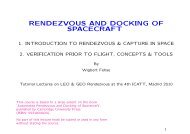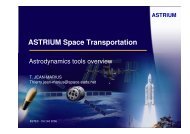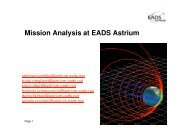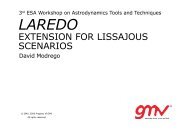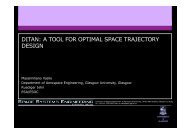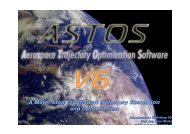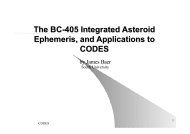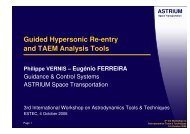GNC/AOCS development system for Rendez-vous and Docking ...
GNC/AOCS development system for Rendez-vous and Docking ...
GNC/AOCS development system for Rendez-vous and Docking ...
You also want an ePaper? Increase the reach of your titles
YUMPU automatically turns print PDFs into web optimized ePapers that Google loves.
Ingeniería y Sistemas S.A.<br />
.<br />
<strong>GNC</strong>/<strong>AOCS</strong> DEVELOPMENT SYSTEM FOR RENDEZ-VOUS AND DOCKING<br />
MISSIONS AT SENER, AND ASSOCIATED TEST FACILITIES<br />
Gonzalo Saavedra, Antonio Ayuso, Juan Manuel del Cura,<br />
Jose Maria Fern<strong>and</strong>ez, Salvador Llorente, Raul Sanchez<br />
demetrio.zorita@sener.es<br />
© SENER
Ingeniería y Sistemas S.A.<br />
CONTENTS<br />
INTRODUCTION<br />
SPECIFIC RVD MISSIONS & TOOLS<br />
ASVIS<br />
RENDEZVOUS AND DOCKING DEMONSTRATION MISSION<br />
CONEXPRESS<br />
GATB (Generic <strong>AOCS</strong> Test Bench)<br />
CONCLUSION<br />
© SENER
Ingeniería y Sistemas S.A.<br />
INTRODUCTION<br />
• The involvement of SENER in <strong>Rendez</strong>-Vous <strong>and</strong> <strong>Docking</strong> activities has<br />
been recently focused in three missions:<br />
•ASVIS (Automatic Servicing Vehicle <strong>for</strong> ISS Surveying)<br />
•Automatic <strong>Rendez</strong><strong>vous</strong> <strong>and</strong> <strong>Docking</strong> Demonstration Mission<br />
•ConeXpress<br />
• Generic <strong>AOCS</strong> Test Bench <strong>development</strong>→GATB<br />
© SENER
Ingeniería y Sistemas S.A.<br />
ASVIS: DESCRIPTION<br />
• ASVIS (Automatic Servicing Vehicle <strong>for</strong> ISS Surveying) is an operative <strong>system</strong> <strong>for</strong><br />
providing ISS services like inspection at different ranges, both periodical <strong>and</strong> ondem<strong>and</strong><br />
<strong>and</strong> support to EVA<br />
• The <strong>GNC</strong> validation has been per<strong>for</strong>med in two steps:<br />
•First, a simulator called ASMIS developed in the<br />
Matlab/Simulink environment that demonstrates the<br />
validity of the <strong>GNC</strong> concept.<br />
•The second step of the validation process is the<br />
migration of the Simulink simulator to the<br />
EuroSim/Linux environment. <strong>GNC</strong> algorithms are<br />
implemented in a Minicraddle plat<strong>for</strong>m based on<br />
ERC32, which is controlled <strong>and</strong> operated from a<br />
laptop.<br />
© SENER
Ingeniería y Sistemas S.A.<br />
ASVIS: ASMIS<br />
• Simulator architecture:<br />
•On board processor <strong>and</strong> Failure<br />
Detection <strong>and</strong> Isolation functions<br />
•Dynamic, Kinematic <strong>and</strong> Environment<br />
•Sensors <strong>and</strong> actuators models<br />
•Communications coverage with ISS<br />
•ISS sensors<br />
•Rest of ASVIS Sub<strong>system</strong>s block<br />
•Guidance block<br />
•Introduction of off-nominal conditions.<br />
© SENER
Ingeniería y Sistemas S.A.<br />
ASVIS: TEST BENCH &VISUALIZATION TOOL<br />
• Test Bench elements:<br />
•PC: Environment Code running on Eurosim under Linux.<br />
•Mini<strong>for</strong>ce: Simulated On Board <strong>GNC</strong> Software running on the flight representative TARSYS<br />
mother board with ERC32 architecture.<br />
•Interface Boards: Between both stations.<br />
• All the models were developed with<br />
Matlab/Simulink.<br />
• OBSW code in Matlab/Simulink <strong>for</strong>mat<br />
is trans<strong>for</strong>med into C code using the<br />
Real Time Workshop. Then, it is crosscompiled<br />
into ERC32 executable file.<br />
And finally, it is downloaded into the<br />
TARSYS board<br />
• Visualization Tool architecture is based on Eurosim <strong>and</strong> 3D visualization tool<br />
© SENER
Ingeniería y Sistemas S.A.<br />
RENDEZVOUS AND DOCKING DEMONSTRATION MISSION: DESCRIPTION<br />
• The main goals of this mission, denoted the “<strong>Rendez</strong><strong>vous</strong> <strong>and</strong> <strong>Docking</strong> Demonstration Mission<br />
(RVDM) are:<br />
•Technology demonstration such as the electromagnetic capture <strong>and</strong> soft docking function of the IBDM<br />
(International Berthing <strong>and</strong> <strong>Docking</strong> Mechanism).<br />
•Risk mitigation <strong>for</strong> future applications of automatic rendez<strong>vous</strong><br />
•<strong>Docking</strong> without the use of absolute or relative GPS (in circular <strong>and</strong> elliptical orbit).<br />
• The baseline of the mission is thus, a Target (PROBA) <strong>and</strong> a Chaser (SMART-1) spacecraft<br />
launched jointly into a circular LEO, carrying the IBDM <strong>and</strong> the Radio Frequency Far Field<br />
sensor (from Darwin Mission) <strong>and</strong> LIDAR (upgraded ATV sensor)<br />
• A software-based simulator (MISSIM) has been developed in order to demonstrate the mission<br />
feasibility <strong>and</strong> assess the pointing <strong>and</strong> position error <strong>and</strong> fuel budget of the concept.<br />
© SENER
Ingeniería y Sistemas S.A.<br />
RENDEZVOUS AND DOCKING DEMONSTRATION MISSION: MISSIM<br />
• The simulator is based on the Generic <strong>AOCS</strong>, which is an on-going internal<br />
<strong>development</strong> of simulation <strong>and</strong> analysis tools in Matlab/Simulink. It contains a large<br />
set of libraries including dynamics/environmental models, actuators, sensors, <strong>GNC</strong><br />
blocks. A special variant <strong>for</strong> rendez-<strong>vous</strong> & docking is available, which is used as the<br />
basis <strong>for</strong> the simulation environment in this project.<br />
• The software simulator contains three main<br />
subprograms:<br />
•Mission Analysis GUI<br />
•MISSIM simulator<br />
•Visualization GUI<br />
© SENER
Ingeniería y Sistemas S.A.<br />
RENDEZVOUS AND DOCKING DEMONSTRATION MISSION: MISSION<br />
ANALYSIS GUI<br />
• Mission Analysis GUI: allows the user to introduce all the orbital data as well as the<br />
mission profile required <strong>for</strong> the mission <strong>and</strong> provide display of ideal results<br />
• The following manoeuvres can be<br />
implemented:<br />
•HOMING/CLOSING<br />
•STATION KEEPING<br />
•FORCED (Linear) APPROACH<br />
•FLY AROUND<br />
•FREE FLIGHT<br />
•DOCKING / UNDOCKING<br />
• Different Attitude predefined profiles<br />
© SENER
Ingeniería y Sistemas S.A.<br />
RENDEZVOUS AND DOCKING DEMONSTRATION MISSION: MISSIM<br />
• MISSIM simulator: main core of the MISSIM software per<strong>for</strong>ming S/C simulations in a<br />
highly realistic environment. The simulator takes into account effects such as:<br />
•Errors in the absolute <strong>and</strong> relative sensors<br />
•Errors in the actuators<br />
•External disturbances<br />
• MISSIM allows the computation of the propellant required <strong>for</strong> the different<br />
manoeuvres, <strong>and</strong> the accuracy obtained at the contact instant.<br />
• Visualization GUI: provides high quality visualization of both S/C’s position, attitude ,<br />
fuel consumption, battery charge, coverage flags of the mission ground stations<br />
(Kiruna, Redu, Villafranca)<br />
© SENER
Ingeniería y Sistemas S.A.<br />
CONEXPRESS: DESCRIPTION<br />
• ConeXpress is a general plat<strong>for</strong>m based on the<br />
use of an Ariane 5 cone adaptor. The ConeXpress<br />
Orbital Life Extension Vehicle (CX-OLEV) mission<br />
services GEO telecommunication satellites that<br />
are almost finishing their mission lifetime while the<br />
payload is still in a good shape. CX-OLEV, once<br />
docked to the Client S/C, will extend its lifetime <strong>for</strong><br />
several years.<br />
• <strong>GNC</strong> SW simulations have been per<strong>for</strong>med to test the per<strong>for</strong>mance <strong>and</strong> functionality of the<br />
<strong>GNC</strong> design. <strong>GNC</strong> SW simulator, developed by SENER, was integrated as one of the<br />
elements of a System simulator <strong>for</strong> the ConeXpress S/C called DSF (Design Simulation<br />
Facility), responsibility of Dutch Space.<br />
© SENER
Ingeniería y Sistemas S.A.<br />
CONEXPRESS<br />
• Simulation SW has been focused in future autocoding<br />
• Model a philosophy based in three principles:<br />
•Simplicity<br />
•Modularity<br />
•Portability<br />
MISSION<br />
TIMELINE<br />
Guidance Navigation Control<br />
• <strong>Docking</strong> phase has been subject to additional analysis in<br />
order to test the contact dynamics between ConeXpress<br />
<strong>and</strong> the Client S/C at the instant of docking. The dynamics<br />
of both S/C (including <strong>GNC</strong>) <strong>and</strong> the <strong>for</strong>ces exchanged in<br />
case of contact allowed to check the success of the<br />
docking strategy.<br />
SENSORS<br />
<strong>GNC</strong>/<strong>AOCS</strong><br />
ACTUATORS<br />
Satellite<br />
Dynamics<br />
© SENER
Ingeniería y Sistemas S.A.<br />
GATB: DESCRIPTION<br />
• Generic <strong>AOCS</strong> Test Bench (GATB) is an adaptable <strong>and</strong> scalable <strong>system</strong> test bench to<br />
validate <strong>and</strong> verify <strong>GNC</strong>/<strong>AOCS</strong> sub<strong>system</strong>s<br />
• The GATB staggered approach offers to the <strong>AOCS</strong> supplier the opportunity to verify<br />
<strong>and</strong> validate the sub<strong>system</strong>, starting from communication principles running in real<br />
time, up to open <strong>and</strong> close loop tests that may include both the On Board Computer<br />
<strong>and</strong>/or the Unit Models –Sensors <strong>and</strong> Actuators– in the loop.<br />
• GATB <strong>for</strong> RVD<br />
• The main four elements of the GATB architecture are:<br />
•Matlab/LabVIEW host<br />
•SCOS 2000 host<br />
•PXI rack<br />
•VME rack<br />
© SENER
Ingeniería y Sistemas S.A.<br />
GATB: Offered Testing Staggered Approach<br />
Step A. The <strong>AOCS</strong> SW <strong>and</strong> the Simulation Software run together in real time in the<br />
processor of the PXI Controller.<br />
• Step B. The <strong>AOCS</strong> SW runs in real time in a flight representative on board processor<br />
–ERC32 or LEON–, whilst the Simulation Software runs also in real time in the PXI<br />
rack.<br />
• Step C. The <strong>AOCS</strong> SW runs in real time in the On Board Computer, while the<br />
Simulation Software runs in real time in the PXI rack. Interface between both devices<br />
is per<strong>for</strong>med via the I/O boards plus the data bus boards.<br />
• Step D. Same as Step C but additional flight hardware –Sensors <strong>and</strong>/or Actuators–<br />
may be included in the loop.<br />
© SENER
Ingeniería y Sistemas S.A.<br />
GATB: Offered Testing Staggered Approach – Step D<br />
© SENER
Ingeniería y Sistemas S.A.<br />
GATB: APPLICATION IN CONEXPRESS FRAME<br />
• The levels of testing <strong>and</strong> the corresponding use of GATB with steps proposed are<br />
hereafter listed:<br />
•Software Validation with two possibilities<br />
•Use of GATB Step B<br />
•Use of CX EM ERC32 board<br />
• Hardware In the Loop Testing<br />
• Focused in DHU (GATB steps C/D)<br />
• Focused in DPCU (GATB steps C/D)<br />
•Overall EGSE (GATB steps C/D)<br />
•<strong>Docking</strong> Payload Test in EPOS (GATB steps C/D)<br />
• Spacecraft Simulator <strong>for</strong> Operations: proposed approach is to use the overall<br />
ConeXpress Test Bench configuration with Engineering Models units in the loop<br />
© SENER
Ingeniería y Sistemas S.A.<br />
Software Validation<br />
• The software is validated in real time close loop tests running in an ERC32 processor.<br />
Two alternatives: GATB Step B <strong>and</strong> using CX EM ERC32 board. The latest would be<br />
preferred since real interfaces are tested (CAN bus).<br />
© SENER
Ingeniería y Sistemas S.A.<br />
HIL Testing – DHU Focused<br />
© SENER
Ingeniería y Sistemas S.A.<br />
HIL Testing – DPCU Focused<br />
© SENER
Ingeniería y Sistemas S.A.<br />
HIL Testing – Overall EGSE<br />
© SENER
Ingeniería y Sistemas S.A.<br />
HIL Testing – <strong>Docking</strong> Payload Testing in EPOS<br />
• Feasibility of the proposed test must be carefully considered gathering the test bench<br />
capabilities together with the EPOS per<strong>for</strong>mances.<br />
© SENER
Ingeniería y Sistemas S.A.<br />
CONCLUSIONS<br />
• The involvement of SENER in RVD missions has led into <strong>development</strong> of<br />
tools that enhance SENER capabilities in order to per<strong>for</strong>m <strong>GNC</strong> design,<br />
verification <strong>and</strong> validation <strong>for</strong> RVD missions.<br />
• The tools developed cover a wide set of functionalities:<br />
•MISSIM allows designing <strong>and</strong> testing the per<strong>for</strong>mance of <strong>Rendez</strong>-Vous a <strong>Docking</strong><br />
strategies.<br />
•<strong>GNC</strong> design <strong>for</strong> both ASVIS <strong>and</strong> ConeXpress has been tested (functionality <strong>and</strong><br />
per<strong>for</strong>mance) by dedicated simulators based on Simulink developing environments.<br />
•GATB→HIL verification <strong>system</strong>s are available at SENER including target computer<br />
in the loop, capability <strong>for</strong> all front-end simulation, <strong>and</strong> integration of HIL sensors <strong>and</strong><br />
actuators<br />
© SENER



